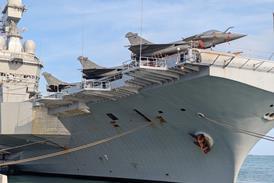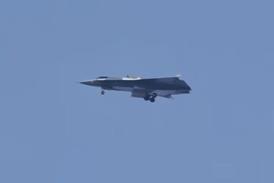Development of hydrogen-powered aircraft remains stuck in low gear. What is stalling this apparently highly efficient and environmentally sound technology?
The hydrogen economy is often touted as a solution to the hydrocarbon ills of the oil dependent transport systems that exist today. Hydrogen-powered aircraft would appear to kill two birds with one stone by ending greenhouse gas and nitrous oxide pollution from jet engines, while being highly efficient.
Yet although the technology forelectrochemical powerplants has been in existence since 1839, they are still not in widespread use.
The theory of fuel cells is not complicated. They have no moving parts and operate like batteries, combining a fuel, typically hydrogen, and an oxidant, usually oxygen from the air, without any combustion. But while battery use is all-pervasive, fuel cells are still in the laboratory. Like the introduction of all new technologies, the device must not only be as cheap as the competition already in use, it has to be substantially cheaper if infrastructure changes are required.
Problem solving
Fuel cells have to beat the turbine, not only in capital, but also installed cost, the cost per kilowatt required to purchase and install it. Research by the UK’s Cranfield University has concluded that fuel cells are still far too heavy for propulsion. A large aircraft requires many megawatts, generated from at least two turbine engines weighing around 3,900kg (8,600lb) each. The Cranfield study found that today’s best fuel cells would generate 670-1,000kW on average and would weigh over 3,200kg each.
But hydrogen and oxygen storage is another serious issue. “There are significant mass implications for the large pressure vessels needed, which are insulated to stop boil off,” says Cranfield University’s professor of aircraft design, John Fielding.
Another major challenge is the electrically driven fans that would be powered by the cells. The fan’s electric motors that would be supplied with electricity by the fuel cell are also still far too large and heavy. The motor’s copper coils are a big problem for this weight obstacle.
One solution is to use cryogenics to create superconducting aluminium, adding more complexity. But that does not stop various organisations from trying to develop hydrogen aircraft.
NASA has studied a fuel cell-powered aircraft the size of a Boeing 737 within its Revolutionary Aeropropulsion Concepts programme. In 2003 the hydrogen 737 study cost $7 million. The solid oxide fuel cell (SOFC) was the engine of choice. That cell was chosen after a three-year, $21 million programme at NASA’s Glenn Research Center on propulsion systems.
Boeing now aims to test an SOFC auxiliary power unit on one of its 737s to investigate its feasibility by 2008. The APU is 45% efficient in turning hydrogen into electricity. In contrast, a gas turbine is 15% efficient. The APU will have a reformer to process jet fuel to obtain the hydrogenand would be used for powering landing-gear movements.
However, Boeing admits that its studies have already found that fuel cells are not economic on current costs. Yet, by 2010, the technology will reach a maturity level at which the APU could be offered on future versions of the Boeing 787. Today the SOFC takes 40min to reach operating temperature so the technology is far from commercial.
Six areas of research broadly under way in Europe and the USA include weight-reducing material selection; increasing the power-to-weight density; lower cost material choices; reducing complexity; minimising temperature constraints, as some cells can get very hot; streamlining manufacturing processes and designing for mass manufacture for substantial unit cost reductions. An example of research for lower-cost material choices is the European Union’s €41 million ($54 million) sixth framework research programme on nanotechnologies and nanosciences, knowledge-based multifunctional materials, new production processes and devices.
Overcoming obstacles
In partnership with the European Space Agency (ESA), the five-year project seeks to find catalysts less expensive than platinum, used widely in fuel cells. “We are looking for an alternative to platinum, a nickel-cobalt-copper alloy. We want some of its properties, but at a lower cost, and nickel, cobalt and copper alloys are a possible solution,” says project co-ordinator David Jarvis, who is based at ESA directorate of human spaceflight in the Netherlands.
These technological hurdles not only manifest themselves on aircraft. The infrastructure that services the aircraft will also be a major obstacle. Hydrogen can be obtained from natural gas, gasoline, coal-gas, methanol, propane, landfill gas, biomass, anerobic digester gas, other fuels containing hydrocarbons, and water. Obtaining hydrogen from water is an energy intensive process called electrolysis, while hydrocarbons require the more efficient “reforming” process.
A major question for automotive studies has been whether the user generates hydrogen on board or obtains it at a hydrogen refinery. The question is equally applicable to aviation. Do you have a reformer on the aircraft, or do you generate the hydrogen centrally? Both have advantages. Reforming on board allows the hydrogen to be transported in a form that is easy to move, such as methanol, natural gas and gasoline. The disadvantage is that having reformers on vehicles is not going to be as efficient as central electricity generation. But how would the hydrogen be produced centrally? A gas- or coal-powered powerplant produces more carbon dioxide, defeating the object of using hydrogen.
Nuclear power is a low carbon cost option, but faces political opposition. Renewable energy sources, such as solar power, wind and wave power, have been proposed as sources of power for electrolysis. But renewable technology is not mature enough. However, in the timeframes considered for the introduction of hydrogen-powered aircraft, renewable energy could be a viable option. Even if renewable energy was available for centralised production, it would require a method of transport to the aircraft. Hydrogen could be piped, but gaseous hydrogen molecules are able to passthrough solids, even stainless steel. In addition hydrogen makes steel brittle and more susceptible to fracture. One option is to store the hydrogen in a medium that releases it when heated.
Research on this has focused on hydrides and pure carbon, or carbon nanotubes doped with metals, but there is a weight penalty. “Liquid hydrogen is the way to store volume [for an aircraft],” says the United Nations’ International Energy Agency’s hydrogen programme executive committee member Nick Beck, who is also chairman of Natural Resources Canada, the Canadian government’s department of energy, based in Ottawa, Ontario.
Practical solutions
NASA is focusing on liquid-hydrogen power as part of its Vehicle Systems programme. This is aimed at breakthrough technologies, including a zero-emissions demonstrator that is a hydrogen-powered fuel-cell aircraft with cryogenic electric motors embedded in the wing (Flight International, 15-22 February). The European Union has similar long-term goals. In May 2002 it completed a two-year, €7.29 million Fifth Framework programme called Liquid Hydrogen-Fuelled Aircraft System Analysis, also known as Cryoplane.

Involving 35 organisations across the EU, Cryoplane aimed to assess practical solutions for the introduction of hydrogen aircraft across all sectors and regions. It also created computer models for fuel system simulation and aircraft propulsion systems. Defining airport infrastructure for fuel production and distribution was also a major element. Since 2002, the EU has continued its study in hydrogen fuel and aviation with its Sixth Framework three-year €7.45 million Helicopter Occupant Safety Technology Application (HELISAFE) project.
Sustainable fuel
This project is researching the use of a sustainable biomass fuel source for aviation that can be integrated into the existing energy infrastructure in the medium term. For the longer term it aims to create a safe and economical way of supplying the developing hydrogen fuel economy. Beyond all the paper studies, flying hardware has been built. NASA and California-based company AeroVironment built the Helios solar-powered remotely operated aircraft. Helios was fitted with a 235kg non-regenerative fuel cell, but crashed into the Pacific in June 2003 before it could draw power from the cell after breaking up in turbulence.
However, AeroVironment achieved another major milestone more recently when it successfully flew the world’s first fuel cell-powered unmanned air vehicle. Although the aircraft was just a scaled model of the planned Global Observer high-altitude long-endurance UAV, it nonetheless marked the first powered flight of its kind. The flight, which took place on 26 May, lasted 1h and used a proton exchange membrane cell with platinum catalyst. “With the full-scale Global Observer we would still use fuel cells. Like the conventional version, the hydrogen UAV could fly for more than a week at 65,000ft [19,800m]. But at that altitude you need a good air compressor,” says AeroVironment managing director Edward Wierzbanowski. Although fuel cells are currently impracticable for airliners, the UAV market may be more interested in hydrogen propulsion. Israel Aircraft Industries is working on mini-UAV applications where flight times last for 4h initially and then later 8h.
Development needed
The European Commission’s UAVNET conference, held in Israel this year, saw the UAVNET’s co-ordinator Mark Okrent talk about civilian fuel cell-powered UAVs. “We believe that there will be a need to perform a number of demonstration projects such as air traffic control integration or high-altitude long-endurance operation with fuel-cell or solar propulsion. It would be a combination of technology and application demonstrations.”
Hardware yet to fly is Boeing’s fuel cell-powered manned glider. It is being developed by the US company’s Spanish operation, but a UK company has provided the fuel cell.
“We have installed a 50kW proton membrane exchange fuel cell, battery hybrid in the glider to show the technology is here, is safe and reliable,” says Intelligent Energy, a Loughborough, UK-based company.
Clearly there are fundamental challenges with fuel-cell technology and substantial development is required for all the systems of any future aircraft to make a hydrogen-powered aircraft possible.

Fuel cells - the clean energy source
A fuel cell uses hydrogen and oxygen to create electricity by an electrochemical process. A single fuel cell typically consists of an electrolyte, two catalyst-coated electrodes, which are the porous anode and cathode, current collectors, separator plates, a manifold and a heat exchanger.
There are different fuel-cell types, but they all operate on the same principle. Hydrogen is fed to the anode where a catalyst, often platinum, separates hydrogen’s negatively charged electrons from positively charged ions, also known as protons.
The protons or the electrons pass through the electrolyte, which is often a non-metallic electrical conductor.
For polymer electrolyte membrane (PEM) cells, protons move through the electrolyte to the cathode to combine with oxygen and electrons, producing water and heat.
For solid oxide fuel cells (SOFC), the negative electrons travel through the electrolyte to the anode where they combine with hydrogen to generate water and electrons.
Because the anode’s electrons cannot pass through the electrolyte, they travel via a circuit and this movement of electrons is an electrical current.
The term used to describe the conductive material in a fuel cell that collects electrons, on the anode side, or disburses electrons on the cathode side, to the circuit, is the current collector. They are microporous allowing fluid flow through them. Channels in the current collectors serve as the distribution pathways for the fuel and oxidant. Gaseous fuel and oxidant can be supplied by the manifold, which can be internal or external.
Finally, there is the heat exchanger that maintains a consistent operating temperature.
They are used by lower-temperature fuel cells, such as PEM, and require water. However, there are also gas and other liquid type versions. The cell, SOFC or PEM, will be linked in different combinations of parallel and series with other cells, in what is called a stack. This is because a cell can produce as little as 1 volt of electrical current. One stack can typically have more than 50 cells, but this varies significantly with stack design.They are separated by separator plates. These also provide the electrical series connections between cells and physically separate the oxidant flow of one cell from the fuel flow of the adjacent cell.
ROB COPPINGER/LONDON
Source: Flight International























